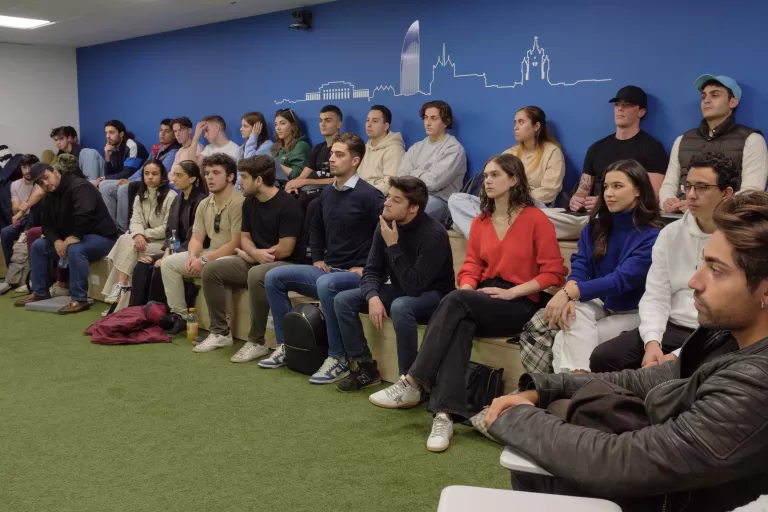What is Blended Learning?
What is the difference between remote and blended learning? What is hybrid learning? Take a look at our guide.
A guide to flexible classrooms after COVID-19
What is the difference between remote and blended learning? What is hybrid learning? What is a flipped classroom? What is synchronous and asynchronous learning? And how will the classroom look at Geneva Business School from September 2020?
So many questions have been raised in the aftermath of the COVID-19 pandemic lockdowns about its effect on education delivery worldwide, and the definitions of blended learning programs are being tested.
Over a billion students worldwide are unable to go to school or university, due to measures to stop the spread of COVID-19. This unprecedented situation has called for an unparalleled global pivot to online education, en masse. The lessons learned about online teaching models will be studied for decades to come.
What does this mean for the terms we used prior to lockdowns and quarantines, and how does it affect your choice of school and learning format for 2020 and beyond? We have tried to answer these questions and more with a quick guide to flexible online classrooms post-COVID-19.
What is blended learning?
Broadly speaking, blended learning combines a mix of learning online and face-to-face instruction. Pre-COVID-19, this meant that a student could complete their studies with online components, asynchronously, that is, in their own time. Traditionally this was an element of classroom management to facilitate a flexible schedule for students and institutions and to adjust delivery methods based on the content, class size, and degree of instruction required.
As digital tools and applications become better adapted to the needs of different learners, course content, and methods of delivery, so too have the course offerings. While classic blended learning combines traditional classroom instruction with asynchronous exercises for independent study, this classical approach is beginning to blend itself.
The shift to emergency remote teaching and learning has sparked a lot of conversations about the evolution of the term “blended learningâ€. A proliferation of the many traditional models of blended learning has illustrated the natural progression of most educational institutions to offer a blend of online and offline learning modes, signaled by the arrival of digital tools in almost every classroom globally.
So, what is the difference between blended learning and hybrid learning? Let’s take a look.
What is hybrid learning?
Hybrid learning, on the other hand, is the method whereby students can be taught remotely and in-person at the same time via virtual teaching tools such as Google Hangouts Meet, Zoom, or Webex. The benefit being that the classroom environment can maintain a group dynamic and results in highly engaged interaction between students, and communication with their faculty is of a higher quality.
Group work can be monitored and facilitated more closely. Peer interaction can be encouraged by teachers and likewise, teachers can interact more with their class. For the institution, the opportunity to provide an improved learning experience ensures that more effective training takes place.
What is a flipped classroom?
The flipped classroom is a type of blended learning model in which students view lecture material prior to class, then spend class time engaging in exercises under the supervision of the teacher. It may be further enhanced with homework and activities used to follow up after class. Tools such as Udemy, or Coursera can augment a curriculum to assist the students when preparing to start a new topic, effectively working as a warm-up.
What is synchronous and asynchronous learning?
Synchronous learning is online or distance education that happens in real-time, whereas asynchronous learning occurs through online channels without real-time interaction. The benefits of synchronous learning are highly engaged class time, deeper bonds with your teaching staff, and a dynamic learning environment. The downside is that the schedule is inflexible and oftentimes technical challenges can waste class time or even prohibit students from attending.
Asynchronous learning allows the student to complete their work within a given time frame, outside of the regularly scheduled class times. Asynchronous classwork can benefit the student who is easily distracted in class or prefers to work at their own pace.
What does all this mean for Geneva Business School students?
We are currently delivering emergency remote teaching (ERT) 100% online and will continue to do so as long as the global pandemic situation requires. As quarantine restrictions are lifted in each country we will deliver hybrid learning, that is, welcoming students back on campus while continuing to deliver all classwork online to all students.
Our faculty are currently delivering a combination of synchronous and asynchronous coursework, and sometimes flipping the classroom, to set the scene for a class. We will always provide project-based assignments to encourage collaboration and breed healthy teamwork.
Geneva Business School will accommodate students who want to remain at home until the situation is clearly resolved. Students may continue to study remotely with the aim of eventually arriving on campus, with the same level of personalized mentoring.
Students will be able to start their September semester virtually and come back to campus whenever it is safe and possible to do so, with our active support for a smooth transition from remote learning back into the classroom. Once travel restrictions are lifted, and general conditions return to normal, we fully expect students to come physically to campus for face to face learning.
As we navigate this new period in our history, we will be flipping the classrooms more extensively than ever before, to create an even better classroom experience for our students and our faculty. As a result, we are confident that both students on campus and those who join us remotely will have a better learning experience.






